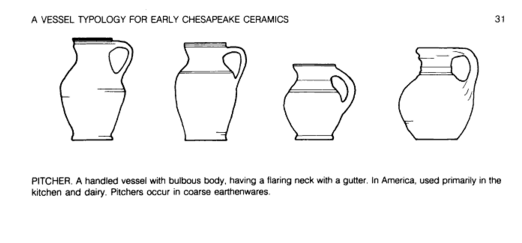Written by the TreasureGuide for the exclusive use of treasurebeachesreport.blogspot.com.
 |
| Source: http://anthropology.tamu.edu/papers/Donachie-PhD2001.pdf |
The illustration shows a protected water situation where mud or silt has settled and sea grass is growing. An ocean beach would have more waves, which would keep silt and mud from settling and not allow sea grass to grow. Silt and mud would be moved to deeper water where the waves would not stir things up while sand, shells and other bits and pieces would be washed up onto the beach and back down from time to time. Some ceramics and glassware would flow in and out very much like sea shells.
In the same dissertation mention was made of a ceramics classification system (POTS). That typology can be found in A Vessel Typology for Early Chesapeake Ceramics: The Potomac Typological System by Beaudry, Long, Miller, Neiman and Stone, in Historical Archaeology 17(1):18-42.

The pictures and definitions can be helpful.
Watch for ceramics, bottles and shards. They are one of the first clues you will often get to a good detecting location.
Some people use a metal probe to probe the mud or sand for bottles or other ceramics or glass. On land sites, you'll only have to look at the surface.
Another thing to look for in shallow protected water, is clumps of moss. An unusual clump might be attached to a bottle. Sometimes it will be a piece of wood or something, but one of my favorite bottle finds was made when I investigated a clump of sea grass sticking up in an otherwise plain sandy area. The sea grass was stuck to the bottle. It was a nice old blob top.
Here are a couple excellent resources about historic ceramics.
http://www.connarchaeology.org/html/historic_ceramics.html
http://nautarch.tamu.edu/class/313/ceramics/period-1.htm
I'll post some pictures of Treaure Coast ceramics including Native American up to 20th century.
---
This was one beautiful day. Warm and calm with very little surf. The surf will be small but increasing very slightly over the next few days.
Happy hunting,
TreasureGuide@comcast.net


